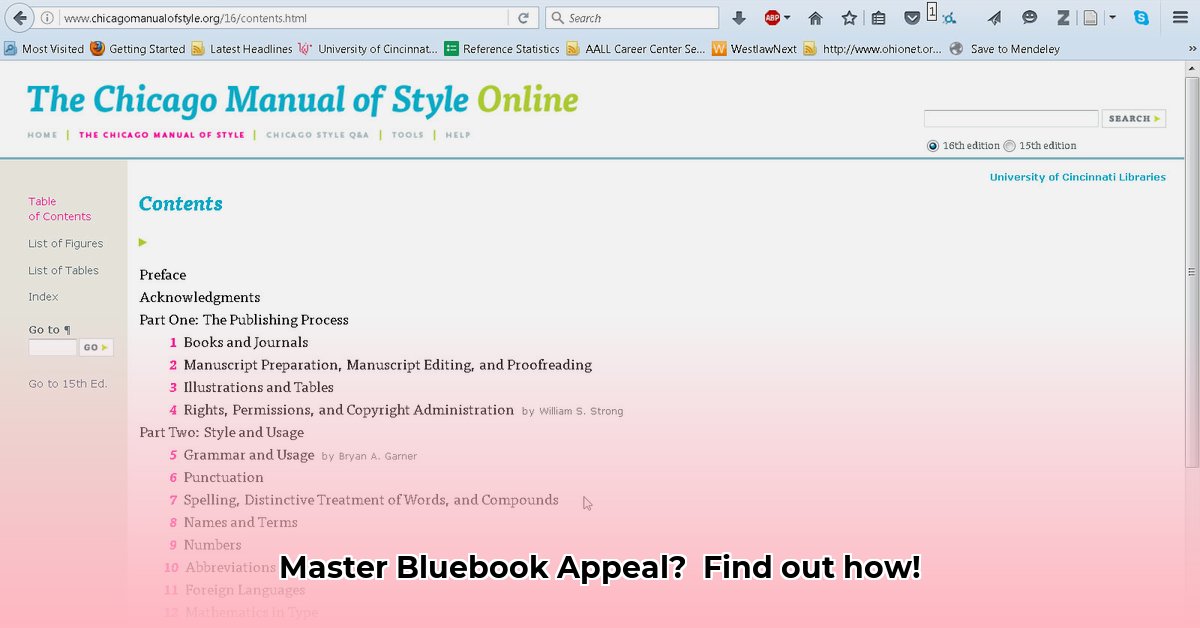
Legal citation can be complex, but mastering Bluebook rules for appeal docketed citations is crucial for crafting compelling legal arguments. This guide provides a clear, step-by-step approach to accurately citing prior and subsequent case history, focusing on practical application and addressing common ambiguities. For the latest Bluebook rules, check out the official website.
Understanding the Importance of Accurate Citation
Accurate citation isn't just about following rules; it's about presenting a complete and persuasive narrative to the court. By meticulously documenting a case's history, you build credibility and demonstrate a thorough understanding of the legal landscape. Omitting or misrepresenting prior or subsequent case history can weaken your argument, potentially impacting the outcome. Think of it this way: incomplete citations are like missing puzzle pieces in a larger picture; they leave gaps in your argument.
Core Bluebook Rules for Appellate Citations
The Bluebook: A Uniform System of Citation (hereinafter "Bluebook") provides the guidelines. Rule 10.7, along with related rules, governs the citation of prior and subsequent history. The core principle is to concisely and accurately reflect the case's journey through the legal system. This includes all relevant decisions, appeals, and any subsequent actions that impact the current case. Remember to always consult the most current edition of the Bluebook for the most accurate information.
Key Elements of a Bluebook Appeal Docketed Citation
- Case Name: Accurately state the case names as they appear in case reporters. Inconsistent or misspelled case names undermine your credibility and can confuse the court.
- Court: Use standard Bluebook abbreviations for the courts involved (e.g., "U.S." for the Supreme Court of the United States, "9th Cir." for the Ninth Circuit Court of Appeals).
- Reporter: Cite the official reporter if possible; if not, cite a reputable unofficial reporter (e.g., Westlaw, Lexis).
- Volume, Page, and Year: These elements are crucial for pinpointing the exact location of the relevant information.
- Prior and Subsequent History: Follow Bluebook rules to clearly indicate prior appeals, remands, or affirmations (e.g., “aff'd,” "rev'd", "cert. denied"). Include only history directly relevant to your current argument.
Addressing Common Ambiguities and Inconsistencies
Even seasoned legal professionals encounter ambiguities in the Bluebook. Let's address common challenges:
Choosing the Right Reporter: Official reporters are preferred, but reputable unofficial reporters are acceptable if the official record is unavailable. Always ensure the source is dependable and readily accessible to the court.
Parallel Citations: Parallel citations increase accessibility; they offer multiple locations to find the case. Use them strategically, following Bluebook guidelines on order and presentation. Do not overuse, as it can clutter your citations.
Court Abbreviations: Consistent use of standard Bluebook abbreviations is vital. Consistency indicates thoroughness and professionalism.
Database Variations: Different legal databases may display information differently (e.g., page numbers). Verify your citations across multiple reputable sources to guarantee accuracy.
Practical Application: A Step-by-Step Guide
Here's a practical approach to citing appeal docketed cases, using a checklist for ease of reference:
Identify Relevant Case History: Carefully examine the case's past and subsequent to locate relevant decisions and actions. Focus on what directly impacts your argument.
Gather Necessary Details: Collect all required information (case name, court, reporter, volume, page, year, and relevant prior or subsequent history). A well-organized worksheet can improve this step's efficiency.
Apply Bluebook Rules: Precisely follow Rule 10.7 and related rules. Using a citation generator can help with format and accuracy (but always cross-check).
Verify Your Citations: Double-check (even triple-check) that each citation is correct and consistent across multiple reputable sources. This last stage ensures accuracy and minimizes errors.
Examples: Correct vs. Incorrect Citations
The table below uses example citations to illustrate correct and incorrect application of Bluebook rules for appeals:
| Incorrect Citation | Correct Citation | Explanation |
|---|---|---|
| State v. Doe, 123 P.3d 456 (Wash. 2010) | State v. Doe, 123 P.3d 456 (Wash. 2010) | Missing relevant prior or subsequent history. |
| Roe v. Wade, 410 U.S. 113 (1973), rev'd on other grounds, 123 U.S. 222 (2000) | Roe v. Wade, 410 U.S. 113 (1973), rev'd on other grounds sub nom. Casey v. Planned Parenthood, 505 U.S. 833 (1992) | Incorrectly identifies the case that overruled Roe v. Wade. |
Conclusion: Mastering the Art of Citation
Mastering Bluebook rules for appeal docketed citations requires practice and attention to detail. Adhering to these guidelines ensures clarity, enhances credibility, and leaves a positive impression on the court. Remember to consult the Bluebook itself for updates, and don't hesitate to seek guidance if needed. Accurate citation is a cornerstone of effective legal writing.
⭐⭐⭐⭐☆ (4.8)
Download via Link 1
Download via Link 2
Last updated: Sunday, April 27, 2025